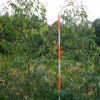 Eucalyptus is a diverse genus with over 700 species, most of which are native to Australia. Numerous Eucalyptus species and hybrid clones have been introduced in temperate climates throughout the world and grown as ornamental trees as well as for fuel and fiber. There is renewed interest in planting this fast-growing tree in the southeastern United States for mulch, pulpwood, and bio-energy. However, several silvicultural challenges exist, and competing vegetation control is a significant one. This 7-page fact sheet was written by Anna Osiecka and Patrick Minogue, and published by the UF Department of School of Forest Resources and Conservation, February 2013.
Eucalyptus is a diverse genus with over 700 species, most of which are native to Australia. Numerous Eucalyptus species and hybrid clones have been introduced in temperate climates throughout the world and grown as ornamental trees as well as for fuel and fiber. There is renewed interest in planting this fast-growing tree in the southeastern United States for mulch, pulpwood, and bio-energy. However, several silvicultural challenges exist, and competing vegetation control is a significant one. This 7-page fact sheet was written by Anna Osiecka and Patrick Minogue, and published by the UF Department of School of Forest Resources and Conservation, February 2013.
http://edis.ifas.ufl.edu/fr378
Tag: Patrick Minogue
Forest Herbicide Characteristics (FOR283/FR345)
 The effectiveness and safe use of herbicides registered for forest vegetation management in Florida requires developing site-specific herbicide prescriptions made with careful consideration of site factors and knowledge of the chemical and physical properties of herbicides and their effects on biological systems. This 9-page fact sheet was written by Anna Osiecka and Patrick J. Minogue, and published by the UF Department of School of Forest Resources and Conservation, May 2011.
The effectiveness and safe use of herbicides registered for forest vegetation management in Florida requires developing site-specific herbicide prescriptions made with careful consideration of site factors and knowledge of the chemical and physical properties of herbicides and their effects on biological systems. This 9-page fact sheet was written by Anna Osiecka and Patrick J. Minogue, and published by the UF Department of School of Forest Resources and Conservation, May 2011.
http://edis.ifas.ufl.edu/fr345
Control y Biología del Helecho Trepador Japonés (Lygodium japonicum) (FOR282/FR344)
This 7-page Spanish-language fact sheet describes this non-native, invasive vine which is widespread in damp areas in north and West Florida — its biology and control measures. Written by Patrick J. Minogue, Daniela Chevasco, Francisco Escobedo, and Kimberly K. Bohn, and published by the UF Department of School of Forest Resources and Conservation, December 2010.
http://edis.ifas.ufl.edu/fr344
SSFOR13/FR064 Longleaf Pine Regeneration
SSFOR13, a 8-page fact sheet by Chris Demers, Alan Long and Patrick Minogue, provides landowners with long-term, multiple-use resource management objectives with strategies for artificial and natural regeneration of this insect-, disease- and fire-resistant species. Includes references. Published by the UF Department of School of Forest Resources and Conservation, November 2010.
http://edis.ifas.ufl.edu/fr064
FOR218/FR280 Biology and Control of Japanese Climbing Fern (Lygodium japonicum)
FOR-218, a 7-page illustrated fact sheet by Patrick J. Minogue, Stella Jones, Kimberly K. Bohn, and Rick L. Williams, describes this non-native, invasive vine which is widespread in damp areas in north and West Florida — its biology and control measures. Includes references. Published by the UF School of Forest Resources and Conservation, May 2009.
http://edis.ifas.ufl.edu/FR280
CIR1475/FR158 Herbicides Registered for Pine Management in Florida – 2008
Revised! Circular 1475, a 14-page fact sheet by Anna Osiecka, Patrick Minogue, Alan Long, Jarek Nowak, and Mark Mossler, provides comprehensive information about the herbicides currently registered for use in Florida pine plantations. Published by the UF School of Forest Resources and Conservation, February 2009.
http://edis.ifas.ufl.edu/FR158
WEC249/UW293 Managing Oaks to Produce Food for Wildlife
WEC-249, a 5-page illustrated fact sheet by Holly K. Ober and Patrick J. Minogue, describes the reasons homeowners should consider planting oaks, how to select the right oak species for a given site, and how to improve wildlife habitat in established stands. Includes references. Published by the UF Department of Wildlife Ecology and Conservation, August 2008.
http://edis.ifas.ufl.edu/UW293
FOR191/FR252 Biology and Management of Cogongrass
FOR-191, a 3-page illustrated fact sheet by Rick Williams and Patrick J. Minogue, describes the biology and management strategies for this noxious weed native to warm regions of southeast Asia that can cause loss of productive forest areas, hinder forest activities and severely degrade wildlife habitat by replacing native plants. Includes references. Published by the UF School of Forest Resources and Conservation, May 2008.
http://edis.ifas.ufl.edu/FR252
FOR189/FR250 Biology and Management of Chinese Privet
FOR-189, a 3-page illustrated fact sheet by Rick Williams and Patrick Minogue, describes this semi-evergreen to evergreen thick-forming shrub which was introduced as an ornamental shrub in the South in 1852 and is widely naturalized in the Panhandle and northern counties — its biology and management strategies. Includes references. Published by the UF School of Forest Resources and Conservation, July 2008.
http://edis.ifas.ufl.edu/FR250
FOR190/FR251 Biology and Management of Chinese Tallow Tree
FOR-190, a 3-page illustrated fact sheet by Rick Williams and Patrick Minogue, describes this noxious weed introduced originally for oil production and favored as an ornamental, its biology and management strategies.
http://edis.ifas.ufl.edu/FR251